Had your fill of turkey? Tired of hearing your relatives talk? Then sneak away and play some Genesis upstairs? At someone else’s house this year? Bet you’re sorry you didn’t get a Nomad! Well, at lease take comfort in reading what other Sega fans have been playing this month. At the very least, it will keep your mind off the fact that you’re going to be eating leftover turkey for another week.
Starblade By Ken Horowitz
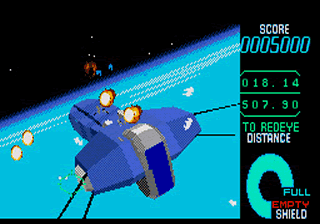 I’ve been putting off buying a copy of Starblade for some time now, though I don’t know why. I loved the arcade original, with its massive cab and curved glass. It made you feel like you were in an actual ship. Hmm, come to think of it, that’s probably why I didn’t want to play Starblade at home. There was simply no way of recreating that great arcade experience.
I’ve been putting off buying a copy of Starblade for some time now, though I don’t know why. I loved the arcade original, with its massive cab and curved glass. It made you feel like you were in an actual ship. Hmm, come to think of it, that’s probably why I didn’t want to play Starblade at home. There was simply no way of recreating that great arcade experience.
When a complete copy finally came up cheap on the ‘bay (free shipping!), I had to pounce. I was pleasantly surprised at how well the game transitioned to the Sega CD, and while the polygon count has been devastated, wire frames do the job nicely. I’m a fan of on-rails shooters, so the gameplay was right up my alley, and the game wasn’t too hard either. I’ve heard that the game was compatible with the Mega Mouse, but I couldn’t get mine to work with it. Still, it plays fine with just the controller, so my enjoyment wasn’t affected.
Overall, I have to say that I’m impressed with the job that was done with this port. It may not be 100% arcade-perfect, but it completely captures the spirit and substance of the original, which was all you can really ask for back then. Nice job Namco!
Metal Fangs By Sebastian Sponsel
This month, I’ve decided to do something I haven’t tried in a long time. I decided to dive into the unknown and try out a Mega Drive game I know little to nothing about. Inspired by a discussion on the Sega-16 forums I stumbled upon this weird game called Metal Fangs. One user posted a few screen shots that intrigued me. The character portraits of the selectable racers looked strangely familiar. One looks remarkable like Robert Smith, lead singer of 70s/”80s goth pioneer band The Cure. Another is a visual carbon copy of an early ’90s Madonna. You got a doppelganger of punk icon Sid Vicious, Morissey and even relativley obscure post-industrial guitarist Blixa Bargeld (of Einstürzende Neubauten and Nick Cave & the Bad Seeds). Yet another one looks like a strange cross between Andy Warhol and Elton John… and I swear I’ve seen that picture of the dude hiding his face behind his face somewhere before! In fact, it seems like every single selectable character is “inspired” by a musician or otherwise artist active in the ’70s and ’80s – with a certain cyberpunk-, industrial-futuristic makeover. So yeah, I definitely had to try it.
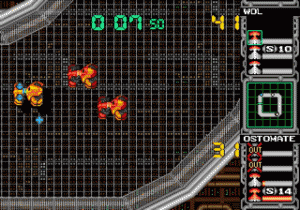 Thing is, it is a strange kind of racing game. Well, I say “racing,” but the more I play it, the less this term seems to apply. At first glance it seems to be some kind of combat racing game in the vein of Rock & Roll Racing, by which I mean you equip your cars with weapons like bombs and missiles and have to battle your opponents during the race. Thing is, you don’t control one cars, but an entire racing team. First you pick four characters, each of which owning some basic stats (like improved defense, a numbered IQ, or some kind of weapon). Between each race you can spend money to improve and equip your drivers. But when the race starts, the cars maneuver more or less on their own. You can switch between each of them and perform a few actions, but you don’t really race your opponents as much as you micromanage your entire team over the course of 2×2 races. You have two “innings,” each consisting one instance where the computer AI hunts down your four drivers with three of his own alternating with one where the roles are reversed. So it’s more like a strategy game… drivers with higher AI IQ can perform more intelligently on their own, cars with higher armor rating can take more damage, bombs only damage cars that are behind a driver but not in front of them, and so forth. So it all comes down to careful planning and managing. How can I make sure that certain drivers can complete as many laps as possible, while receiving little enough damage so that I can send in my hardest hitters in the next round again?
Thing is, it is a strange kind of racing game. Well, I say “racing,” but the more I play it, the less this term seems to apply. At first glance it seems to be some kind of combat racing game in the vein of Rock & Roll Racing, by which I mean you equip your cars with weapons like bombs and missiles and have to battle your opponents during the race. Thing is, you don’t control one cars, but an entire racing team. First you pick four characters, each of which owning some basic stats (like improved defense, a numbered IQ, or some kind of weapon). Between each race you can spend money to improve and equip your drivers. But when the race starts, the cars maneuver more or less on their own. You can switch between each of them and perform a few actions, but you don’t really race your opponents as much as you micromanage your entire team over the course of 2×2 races. You have two “innings,” each consisting one instance where the computer AI hunts down your four drivers with three of his own alternating with one where the roles are reversed. So it’s more like a strategy game… drivers with higher AI IQ can perform more intelligently on their own, cars with higher armor rating can take more damage, bombs only damage cars that are behind a driver but not in front of them, and so forth. So it all comes down to careful planning and managing. How can I make sure that certain drivers can complete as many laps as possible, while receiving little enough damage so that I can send in my hardest hitters in the next round again?
Without any knowledge of Japanese, one would be completely lost in this game. Trying to play it like a regular racing game is a lost cause. Thankfully, forum member Barone was able to provide a few hints on how to play that game, otherwise I wouldn’t have been able to make heads or tails of it. And even with those hints (and some pics of the instructions posted by forum member Thunderblaze16), this game still confounds me in places. Though I have managed to win my first two races now, so there’s at least been some modicum of progress.
Now I just need to find out what the hell a “Salvador” is supposed to do…
Exile By The Coop
Renovation was pretty good at churning out Genesis titles. For a while, they were covering so many bases, you’d think SEGA had hired them to take care of some things on the Genesis for them. Their released titles ranged pretty widely in quality; from the “THIS IS AWESOME!” stuff like Granada and Gaiares, to games that left you sobbing quietly in a corner because you just burned $49.99 away on a copy of Valis: Phantasm Soldier. But they also had a fair number of middle-of-the-road titles that weren’t great or horrid. They were just… there. One such game for me, was Exile.
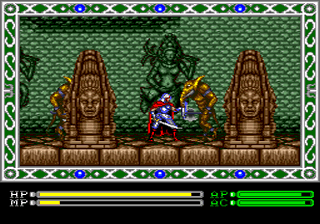 Coming out in 1991, this title was about a man named Adler looking to defeat the army of Luciel, a country who was attacking his homeland. It’s a mix of RPG overworld walking, a little platforming action, some conversations and cinemas to move the plot forward here and there… nothing overly awe-inducing. But there’s one thing that stood out in my mind when I played it for the first time; the game had swearing! OMFGLOL!
Coming out in 1991, this title was about a man named Adler looking to defeat the army of Luciel, a country who was attacking his homeland. It’s a mix of RPG overworld walking, a little platforming action, some conversations and cinemas to move the plot forward here and there… nothing overly awe-inducing. But there’s one thing that stood out in my mind when I played it for the first time; the game had swearing! OMFGLOL!
Yes, the game had some swear words tucked away in its text. Nothing overly vulgar, but occasionally you got a “damn” here and there. The one that I always remember is when a character (can’t remember who) said, “What a resolute ass he is.” For me, the game may as well have just dropped an F-bomb, as I wasn’t used to games having swear words. I laughed after reading, and then left it on the screen so I could run off and get my mom to show her. When she saw it, she asked me what game it was. And for a moment, I thought I done goofed. I figured I was about to watch my game get taken away or something. But nope; it was just my mom feigning interest in a hobby she really didn’t give two turds about. So, I was safe, my filthy-mouthed game was safe, and I continued on save the world.
Sure, that’s tame as all hell these days. F-bombs are dropped quite regularly now, with nudity, violence and all of that good stuff as prevalent today in gaming, as it already was in the movies I was watching back in 1991. But at that time, it was pretty novel for me, and something I can still remember years later. It was like seeing my little game system take another step toward growing up. The Genesis had blood in it, it was swearing at me… and no, I’m not going make a PMS joke here.
Star Control By Goldenband
When I sat down to write this Reader Roundtable entry, I discovered a nifty (and very timely) surprise: it was on Thanksgiving weekend, almost exactly two years ago, that I played Star Control for the first time.
My wife and I live nearly a thousand miles away from my family, and visiting for the holidays means a very long drive. One thing that makes the journey easier, though, is looking forward to the epic video game battles that often happen at our get-togethers. My sisters mostly prefer Atari 2600 and Wii, and their kids gravitate towards the N64 and XBox 360, but my brother is a video game omnivore who’s open to anything. (Heck, he’s even willing to play 3DO with me.)
He’s also the only other Sega aficionado in the family, so right before my wife and I left, I grabbed a handful of Genesis games to play. The grab-bag included some funky titles like Romance of the Three Kingdoms II, but the only one we ended up cracking open was the copy of Star Control I’d recently bought on eBay. Without a glance at the manual, we fired it up and proceeded to have a series of epic battles in melee mode. Neither my brother nor I really knew what we were doing at first, but the Space War-style gameplay was easy enough to figure out, and we got more than a few laughs out of foiling each other.
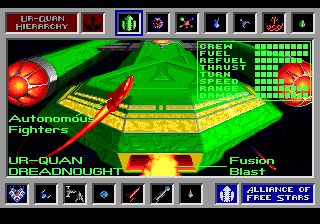 Flash forward two years, and after a long busy period in my professional life that left very little time for gaming, I decided to pull Star Control out again and beat melee mode. As I worked my way up to “awesome” difficulty, I came to appreciate how thoughtfully balanced the combat really is in this game, and how much revolves around picking the right ship at the right time.
Flash forward two years, and after a long busy period in my professional life that left very little time for gaming, I decided to pull Star Control out again and beat melee mode. As I worked my way up to “awesome” difficulty, I came to appreciate how thoughtfully balanced the combat really is in this game, and how much revolves around picking the right ship at the right time.
For example, say the Hierarchy sends the Ilwrath Avenger into battle. This Klingon-esque vessel has a cloaking device and a devastating (but short-range) energy weapon. It might seem natural to counter with the Earthling Cruiser, an obvious clone of the Enterprise, but try it and you’ll find the sluggish Earth vessel is a sitting duck that won’t last 10 seconds. However, the Syreen Penetrator can match the Avenger’s speed and hover just out of weapons range, while using the Syreen Song to slowly siphon off its crew – until turning around to fire a quick coup de grace.
Other match-ups are equally clever and subtle. The powerful Chenjesu wreak major damage with their crystal missile, and can easily overwhelm several foes, but their ship isn’t maneuverable enough to reliably dodge the long-range, heat-seeking plasmoids steadily fired by the Mycon Podship. The Mycon, in turn, are almost powerless against the Yehat Terminator, which can simply block the plasmoid with its shields as needed and close in for a quick kill.
The most comical pairing involves the Ur-Quan Dreadnought, whose massive firepower and complement of autonomous fighters makes it a formidable adversary indeed…except against the tiny, lightly armed Arilou Skiff. True, one well-placed shot from the Dreadnought’s main weapon will destroy the Skiff instantly, but the Arilou vessel is incredibly maneuverable and immune to gravity, allowing it to hover near planets without getting pulled in. By hiding on the far side of a planet, baiting the Dreadnought to attack, and then simply dancing out of the way, the Skiff can gradually wear down the frustrated Ur-Quan, especially since the Dreadnought’s deployable fighters have a nasty habit of crashing straight into the planet, depleting its crew. While the ungainly Dreadnought struggles to avoid a crash of its own, the Skiff can dart in behind the larger ship, fire off a few shots, and retreat to the far side of the planet before the juggernaut can even finish turning around. Lather, rinse, repeat, until the little mouse of a ship triumphs. It’s hard to put into words, but suffice to say, pulling this off is both satisfying and hilarious.
Armed with my new-found knowledge, I’d love to have another Star Control battle with my brother this Thanksgiving, but travel plans this year mean it’s not in the cards. However, I haven’t even touched the main game yet, which places all this combat in a strategic setting with 15 different scenarios to master. So even though I’ve beaten melee mode, Star Control has many unconquered challenges left for me.
Boogie Woogie Bowling By David Dyne
I’ve been a big fan of Championship Bowling by Mentrix on the Genesis, so it was quite a surprise to discover recently that the game was a localized Mega Drive title called Boogie Woogie Bowling from Japan. Boogie Woogie Bowling by Visco is the original name, and it has quite a few differences from its Western counterpart. First up is its roster of characters. Boogie Woogie gives you three manga style kids and an alien creature that’s either a blatant rip off or homage to H.R. Giger’s designs while Championship Bowling serves up two guys and two girls in their early to late twenties.
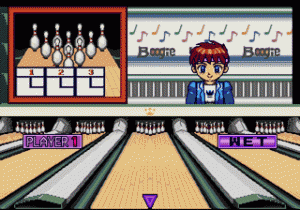 Boogie Woogie’s gameplay differs slightly in how you setup your shots. Normally, a player sets their bowler’s position, selects the amount of spin from a rapidly moving arrow on a multi-colored bar, where they want to aim and then how much power is applied before letting loose with the ball down the lane. Championship Bowling allows the player ample time to determine how much spin you want, while Boogie Woogie gives you a time limit of roughly two to three seconds before the game automatically chooses for you wherever the arrow happens to be on the multi-colored bar when time runs out. If you wait too long, you’ll have to compensate for the computer’s choice of spin through the aiming step and hope your ball doesn’t end up in the gutter.
Boogie Woogie’s gameplay differs slightly in how you setup your shots. Normally, a player sets their bowler’s position, selects the amount of spin from a rapidly moving arrow on a multi-colored bar, where they want to aim and then how much power is applied before letting loose with the ball down the lane. Championship Bowling allows the player ample time to determine how much spin you want, while Boogie Woogie gives you a time limit of roughly two to three seconds before the game automatically chooses for you wherever the arrow happens to be on the multi-colored bar when time runs out. If you wait too long, you’ll have to compensate for the computer’s choice of spin through the aiming step and hope your ball doesn’t end up in the gutter.
Other changes include the background crowd graphics for each player, a rearrangement of the existing soundtrack and overall skill levels of the computer opponents in each of the four matches. Both versions are great casual bowling titles, so sit back this Thanksgiving, fire up either version and let the bowling balls roll between mouthfuls of turkey and pumpkin pie.

Recent Comments